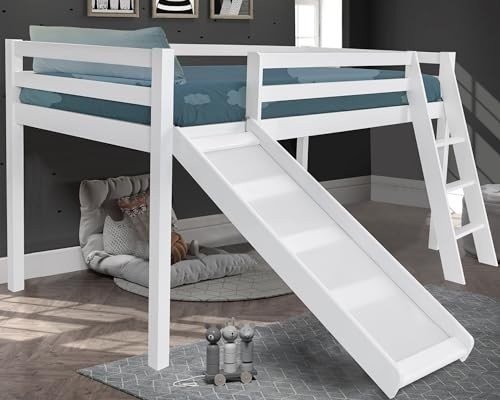10 Things Competitors Teach You About Kids Bunkbed
Title: The Ultimate Guide to Kids Bunk Beds
Introduction
As children grow, so does their need for space and storage options. Bunk beds are an excellent method to make the most of space while providing a fun and functional sleeping plan for your kids. This extensive guide will check out the various types, advantages, security considerations, and FAQs connected to kids bunk beds.
I. Types of Kids Bunk Beds
- Requirement Bunk Beds: These are the most typical type, featuring 2 twin-sized beds stacked on top of each other.
- Futon Bunk Beds: The bottom bunk is replaced with a futon, providing a couch and a bed in one piece of furniture.
- Twin-Over-Full Bunk Beds: The bottom bunk is bigger, accommodating a full-sized bed mattress, while the top bunk is a twin.
- L-Shaped Bunk Beds: These consist of 2 beds put perpendicularly, supplying more floor area below.
- Loft Bunk Beds: A single bed is put on a raised platform, leaving room for a desk, play location, or storage underneath.
II. Advantages of Kids Bunk Beds
- Space-Saving: Bunk beds are ideal for smaller sized bed rooms, maximizing flooring area for other activities and furniture.
- Enjoyable and Exciting: Children often enjoy the novelty and adventure of going up to their own private sleeping area.
- Cost-Effective: Purchasing one bunk bed is more budget-friendly than buying two separate beds.
- Versatile: Many bunk beds can be separated into two different beds as children get older or when area allows.
- Integrated Storage: Some bunk beds include built-in storage services, such as drawers, desks, or shelves.
III. Safety Considerations
- Tough Construction: Ensure the bunk bed is made from durable, resilient products and has a safe ladder for safe access.
- Correct Spacing: Gaps in between the mattress and the frame should be less than 3.5 inches to avoid entrapment.
- Proper Height: Select a bunk bed with a suitable height for your child, considering their age, size, and ability to climb up and down securely.
- Secure Mattresses: Use the appropriate size bed mattress and protect it to the bed frame to prevent it from shifting throughout sleep.
- Guardrails: Ensure guardrails are installed on both sides of the top bunk and are at least 5 inches higher than the top of the mattress.
IV. Frequently asked questions
- What is the ideal age for a child to sleep on the leading bunk?It is normally advised to wait until a child is at least 6 years of ages before permitting them to sleep on the leading bunk.
- Can bunk beds be separated into 2 different beds?Yes, some bunk beds can be taken apart and transformed into two separate beds.
- How much area is required in between the bottom of the leading bunk and the top of the bottom bunk? Alexia of 2 feet 8 inches is advised for head clearance on the bottom bunk.
- Are bunk beds safe for children?When effectively assembled and utilized, bunk beds are safe for children. Always follow safety standards and guarantee your child understands the rules for utilizing the bunk bed.
V. Conclusion
Kids bunk beds are a practical and enjoyable option for making the most of area and supplying a distinct sleeping experience for your children. By thinking about the various types, advantages, and safety factors to consider, you can make an informed choice when picking the best bunk bed for your family.
